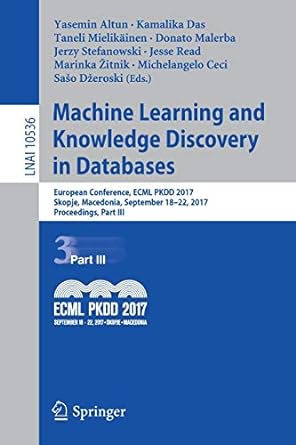Question
Score for this attempt: 7.75 out of 10 Submitted Jan 28 at 10:02pm This attempt took 29 minutes. Question 1 1 / 1 pts
Score for this attempt: 7.75 out of 10\ Submitted Jan 28 at 10:02pm\ This attempt took 29 minutes.\ \ Question 1\ 1 / 1 pts\ Review the discussion about task environments from class and chapter 2.3 of our textbook. Consider an intelligent agent that operates in a manufacturing plant that produces cars. The plant is occupied by people and autonomous robots that assemble the cars. \ \ Consider the task environment for the agent given the environment as discussed above. Check all statements that are true about the environment.\ \ The environment is continuous. \ The environment is partially observable. \ The environment is deterministic. \ The environment is a multi-agent environment. \ \ PartialQuestion 2\ 0.75 / 1 pts\ Mark all that is true about a rational agent as discussed in the lecture and described in chapter 1 of the textbook.\ \ An rational agent operates autonomously. \ A rational agent uses a performance measure. \ A rational agent perceives of its environment. \ A rational agent attempts to achieve the best outcome or the best expected outcome. \ A rational agent must always use inferencing before acting. \ \ Question 3\ 1 / 1 pts\ Consider the following problem. An agent monitors traffic on a highway. It counts passing cars and trucks using a digital camera that takes an image every second. It reports the total number of cars it has detected per minute to a traffic monitoring system. The agent uses image processing techniques and rules to detect the shape of cars and trucks in the digital images. Such an agent closely resembles which of the following agent models discussed in class. Hint: choose the simplest model that fits such an agent.\ \ model-based, goal-based agent \ simple reflex agent \ table-driven agent \ model-based, utility-based agent \ \ Question 4\ 2 / 2 pts\ Given the models for intelligent agents discussed in class and reviewed in chapter 2.4 of our textbook. Which of the following assertions are true about intelligent agents. Mark all that are true.\ \ A simple reflex agent makes correct decisions even when the environment is stochastic. \ A perfectly rational poker-playing agent may lose a game. \ A model-based reflex agent makes a decision even when the world is only partially observable. \ A simple reflex agent cannot change its action rules. \ \ Question 5\ 2 / 2 pts\ Consider a robot world with a robot R in a 4x4 maze. Here are the rules for the robot world:\ The maze has walls restricting the movement of the robot.\ The robot can face east (E), west (W), north (N), or south (S).\ The robot can move to a neighboring cell if there is no wall blocking the robot. It uses the move (M) operation to change the cell location.\ The robot can rotate to change the direction it faces using E, W, N, or S to set its new direction.\ The robot has a specific location in the maze.\ There are up to three targets (T) that can be placed in the maze.\ The robot must traverse the maze to pick up all targets in the maze.\ A maze may not have any targets at all.\ Robots may visit a cell with a target to pick up the target.\ In the initial state of the system, the robot may not be located in a cell where there is a target and there cannot be more than one target in each cell.\ \ Below is a sample maze with the robot R located in cell (2,4) facing north, denoted as R(N), and two targets located in cells (4, 1) and (3, 3), respectively. The north-facing robot can change its direction to R(W) to face west using operation W. The robot can change its location to cell (3, 4). However, it must first rotate to face south before executing the move operation. \ \ HW2 Q5 Maze-1.jpg\ \ Answer the following questions about this maze.\ \ Not considering any targets and assuming that the robot world has a single robot located inside the maze, compute the size of the state space, i.e., the number of states of the robot world: \ 64\ (enter a number only)\ \ A single rotation may rotate the robot from north to south, east to west, or east to north, and so forth. \ \ Including rotations (e.g., north to south), how many steps does it take for the robot to reach the cell of the closest target: \ 15\ (enter a number only)\ \ \ \ \ \ Answer 1:\ 64\ Answer 2:\ 15\ \ PartialQuestion 6\ 1 / 3 pts\ Consider the following map.\ \ HW2 Q6 Map.jpg\ \ Assuming an agent, located at T(imisoara), searches for a path to B(ucharest) using breadth-first search. The agent adds T as the first node into the frontier (FIFO queue).\ \ How many nodes will be in the frontier after the agent pops node T from the list and adds its child nodes to the frontier: \ 2\ (enter a number only)\ \ How many nodes will be in the frontier after the agent pops node A from the list and adds all child nodes of A to the frontier: \ 2\ (enter a number only)\ \ What is the largest number of nodes listed in the frontier before the agent reaches the goal node B and ends its search? \ 3\ (enter a n
Step by Step Solution
There are 3 Steps involved in it
Step: 1

Get Instant Access to Expert-Tailored Solutions
See step-by-step solutions with expert insights and AI powered tools for academic success
Step: 2

Step: 3

Ace Your Homework with AI
Get the answers you need in no time with our AI-driven, step-by-step assistance
Get Started


